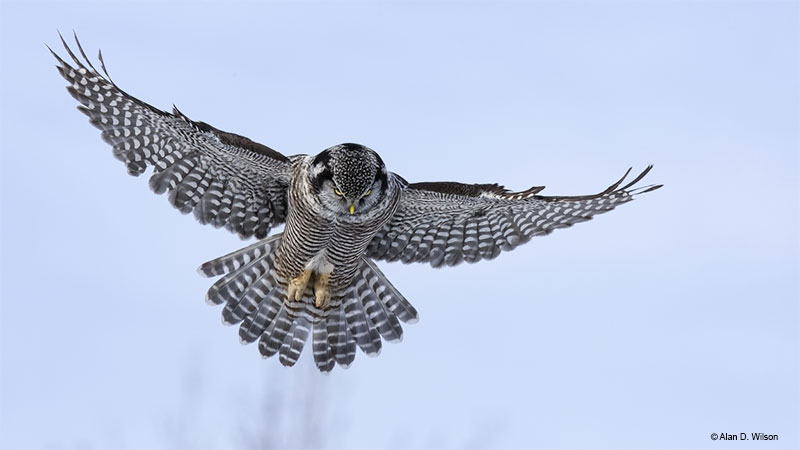
Minnesota is an excellent place for owls. In fact, it might be the best state for seeing different species of owls!
In winter, lots of birders visit northern Minnesota to see rare and uncommon species like Northern Hawk Owl and the Great Gray Owl! Snowy Owls, Short-eared Owls, Long-eared Owls, and Northern Saw-whet Owls are also regular in the state. Not to mention, there are also lots of Barred Owls, Great Horned Owls, and Eastern Screech-Owls!
Which Owl Species Can You See In Minnesota?
Minnesota is loved by several owl species, in fact, based on eBird data, there are around 10 of them! Some are rarer than others, and some only visit once in a while, so keep your eyes peeled for movement.
Here are the owl species you are most likely to see.
Barred Owl
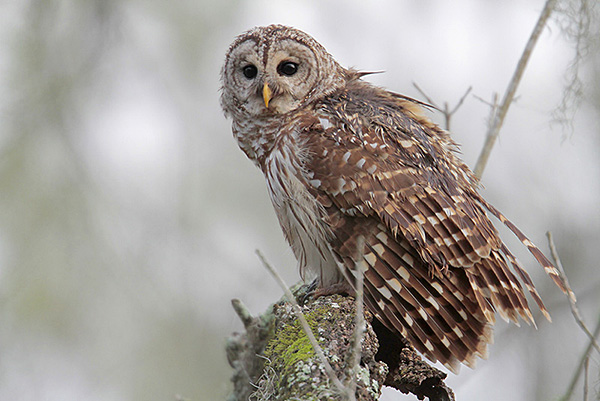
Photograph © Greg Lavaty.
- Range: A permanent resident in most forested areas in Canada, parts of some Pacific Northwestern states, and most of the eastern USA.
- Length: 21 inches
- Wingspan: 42 inches
- Call: Makes loud hooting and caterwalling sounds, “Who cooks for you?! Who cooks for youaaaal!”
The Barred Owl is a medium to large owl with a round head and a narrow black border on its pale gray face. It has dark brown upperparts with white markings, and dark brown streaks on its belly.
This species also has a yellowish beak and dark eyes. Both sexes look the same except that females are a bit larger than males.
The Barred Owl flaps and glides on big, broad wings. It also has a medium-length, broad tail with a few dark brown bands.
Key Identifications:
- Big owl with a round head that has white marks on dark brown upperparts, and dark brown streaks on pale underparts.
- Perches and swoops through wooded areas at night but can also be active in the day.
- Nests in tree cavities and in abandoned nests of crows and hawks.
- Catches a wide variety of small animals.
Great Horned Owl
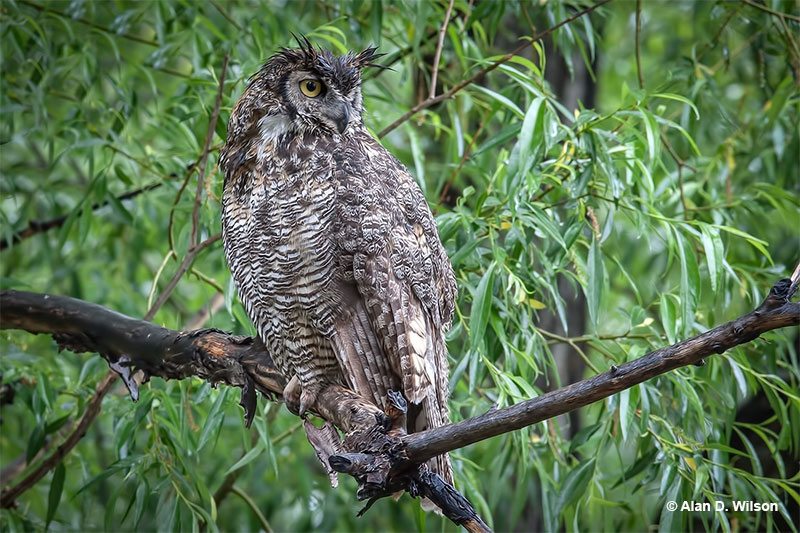
- Range: Permanent resident in much of Alaska, Canada, and the USA.
- Length: 22 inches
- Wingspan: 44 inches
- Call: Makes a low, gruff, “hooo, hoo hoo hoo hoooo”.
The Great Horned Owl is a big, bulky owl with big ear tufts and a black beak. It is mottled gray and brown, has a rufous or gray face, and fine black barring on its underparts. This owl also has a white throat and some dark marks on its breast.
Males and female Great Horned Owls look the same but females are larger. They also have a medium-length tail with dark bands, and long, broad wings.
This nocturnal owl species lives in every possible habitat, including urban areas.
Key Identifications:
- Big, bulky brown or gray owl with ear tufts and fine barring on its underparts.
- Nests in old stick nests of other large birds, on ledges, and in other situations.
- Watches from a perch or glides over open habitats at night, to catch mammals and some birds on the ground.
Snowy Owl
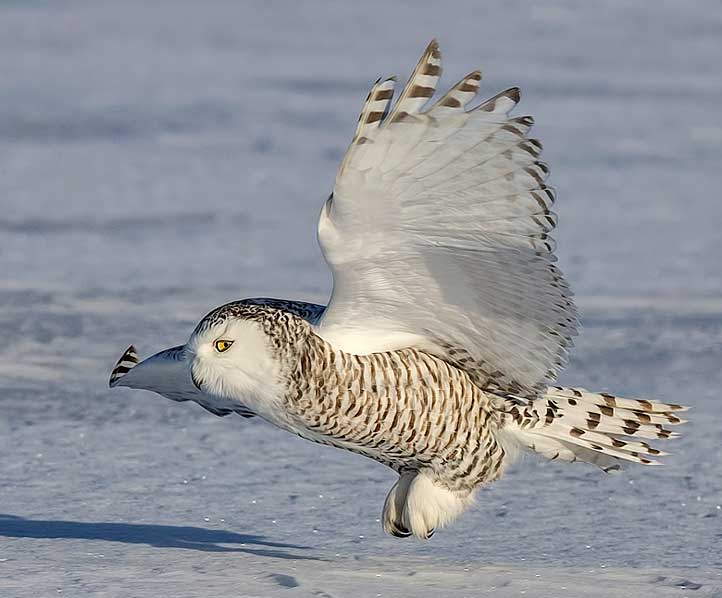
- Range: Summer resident in northern Alaska and northern Canada. It winters in Canada and the northern USA.
- Length: 23 inches
- Wingspan: 52 inches
- Call: Usually quiet but occasionally makes a low, gruff call, “whew…whuh”.
The Snowy Owl is a big, mostly white owl with a round head and yellow eyes. Some males are mostly white but most have some small dark marks. Females and young birds have white faces and varying degrees of black barring.
Related: What is the state bird of Minnesota?
Females are a bit larger than males and have more black markings than males. Snowy Owls also have long, broad wings and a broad tail.
Snowy Owls are regular winterers in Minnesota.
Key Identifications:
- Big white owl with a round head, and varying degrees of black or dark gray barring and spots.
- Lives in tundra and winters in wide open habitats.
- Nests on the ground, on elevated spots in Arctic tundra.
- Watches from a perch and glides low to catch small animals on the ground.
Eastern Screech-Owl
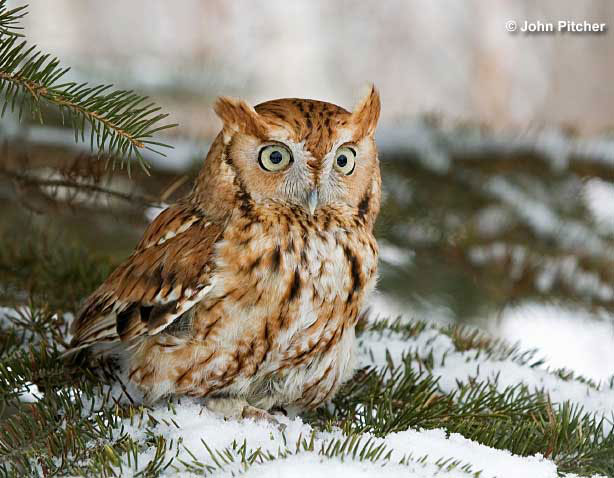
- Range: Permanent resident in parts of southeastern Canada, and in much of the eastern USA.
- Length: 8.5 inches
- Wingspan: 20 inches
- Call: Makes a rather high-pitched, descending whinny call, and a tremulous, vibrating call on the same pitch, “wududududududududududu”.
The Eastern Screech Owl is a small owl with ear tufts. It can be reddish, brown, or mostly gray, has “V”-shaped pale eyebrows, and some black on the edge of its face. It is also mottled above with some white spotting, and has pale underparts with dark barring and streaks.
Males and females look alike but females are a bit larger. This species also has yellow eyes, a pale yellow-gray beak, and some white bands on its broad tail.
During the day, this owl hides in holes, or in dense vegetation.
Key Identifications:
- Small owl with ear tufts and mottled brown or gray plumage that lives east of the Rocky Mountains.
- Lives in a variety of wooded and park-like habitats.
- Nests in tree cavities and nest boxes.
- Swoops down to the ground catch a variety of small animals at night.
Northern Saw-whet Owl
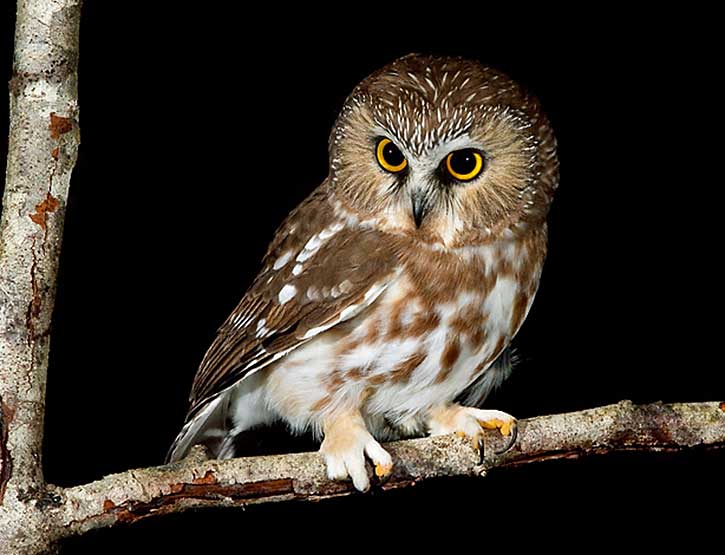
- Range: Lives in coniferous and mixed hardwood forests of Alaska, a large area of Canada, and parts of the northern and western USA.
- Length: 8 inches
- Wingspan: 17 inches
- Call: Makes a repeated tooting whistle call, over and over, “tu, tu, tu, tu, tu, tu, tu, tu, tu”.
The Northern Saw-whet Owl is a small, dark brown owl with a round head and brown streaks on white underparts. It also has some pale streaks on its head, a brown and white face, and some white spotting on its back.
Both sexes look the same but females are a bit larger. This species also has yellow eyes, a dark beak, longish, rounded wings, and a short, broad tail.
The Northern Saw-whet Owl breeds in coniferous and mixed forests. Minnesota is right in between their breeding and wintering range, so if you’re lucky, you might spot them year-round.
Key Identifications:
- Small, dark brown owl with a round head, broad white eyebrows, and thick dark streaks on pale underparts.
- Occurs in dense coniferous and mixed forest.
- Nests in old woodpecker holes and can use nest boxes.
- Swoops down to catch insects and small animals at night.
Long-eared Owl
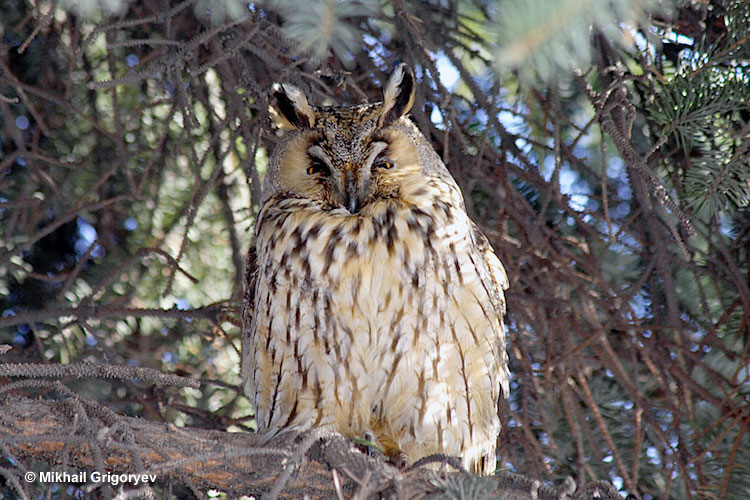
- Range: Migrant in southern Canada, resident and winters in much of the USA. Absent from parts of the Pacific Northwest and southeastern states.
- Length: 15 inches
- Wingspan: 36 inches
- Call: Makes a single, one second long “Hooo!” call at regular intervals.
The Long-eared Owl is a medium-sized, slender owl with long ear tufts. It has an orange face, is mottled gray above, and has dark brown streaks and marks on pale underparts. This owl also has long wings with a rufous patch in its primaries.
Male and female Long-eared Owls look similar but females are larger. This owl species also has yellow eyes, and some pale markings between its eyes and around its dark beak.
This nocturnal owl frequents coniferous woodlands near meadows.
Key Identifications:
- Medium-sized, slender owl species with long ear tufts, orange on its face, and long wings with an orange-brown patch near the wingtips.
- Occurs in coniferous and mixed forests near meadows, bogs, and other open areas.
- Nests in old crow, magpie, and hawk nests.
- Glides over open habitats near forest at night to catch small animals on the ground.
Short-eared Owl
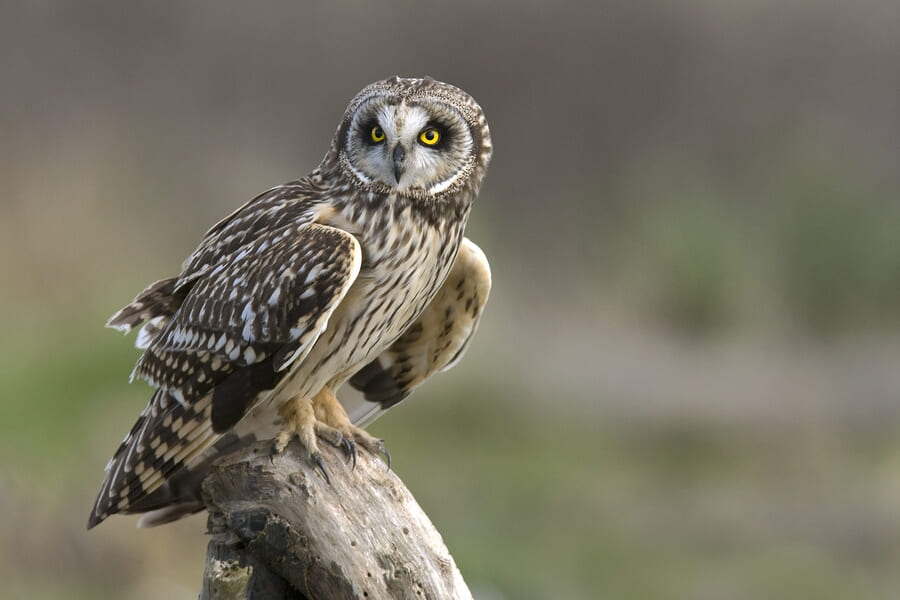
- Range: Summer resident in Alaska, Canada, and the western and central USA. Northern birds migrate to the USA, south to California and Texas.
- Length: 15 inches
- Wingspan: 38 inches
- Call: Makes a hoarse, raspy, cat-like call, “rehw”.
The Short-eared Owl is a medium-sized, pale brown owl with dark eye patches on a pale face. They have a dark breast and streaks on pale underparts. This species has long wings with buff wing patches.
Both sexes look similar but females are a bit larger and usually darker and buffier.
This owl is active day and night in open fields.
Key Identifications:
- Medium-sized pale brown and buffy owl with very short ear tufts.
- Dark eye patches on a pale face and long wings with buff patches near the wingtips.
- Nests on the ground in dense vegetation.
- Glides over open fields to catch small animals on the ground.
Great Gray Owl
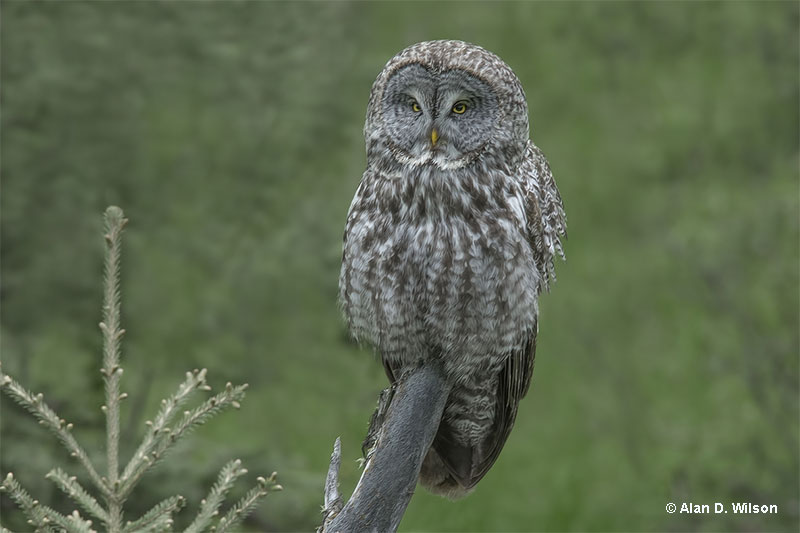
© Alan D. Wilson
- Range: Permanent resident in Alaska, northern Canada east to Ontario, and in the northern Rocky Mountains south to Yellowstone. Some birds winter in the northern USA and southeastern Canada.
- Length: 27 inches
- Wingspan: 52 inches
- Call: Makes ten, low hoot calls, the first and final notes lower than the others, “woot…hoo..hoo..hoo..hoo..hoo..hoo..hoo..hoo..hoo”.
The Great Gray Owl is a huge owl with a big, round head, and is dark gray with some pale mottling. It has a narrow black border on its face and two white marks on its throat.
Both sexes of the Great Gray Owl look the same although females are larger. They have yellow eyes, a yellowish beak, and a broad, medium-length tail.
This owl species also has long, broad wings with dark barring and a buffy patch near the wingtips.
Great Gray Owls are not too common in Minnesota, but they are often seen during birding tours.
Key Identifications:
- Huge, dark gray owl with a big round head, and two small white patches on its throat.
- Lives in boreal forests with bogs and other openings.
- Nests in old raptor nests and on platforms.
- Catches voles and other small rodents on the ground.
Northern Hawk Owl – rare
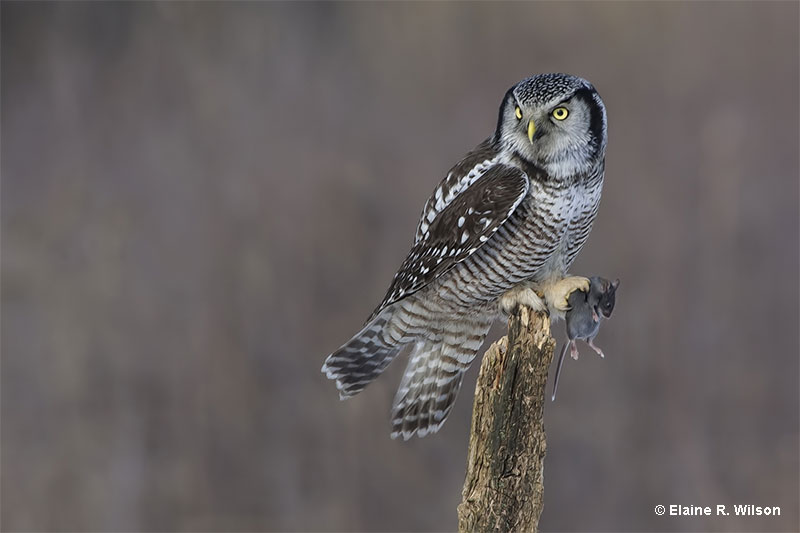
© Elaine R. Wilson
- Range: Permanent resident in Alaska and a large area of Canada. In the winter, some birds reach the northern USA and southern Canada.
- Length: 16 inches
- Wingspan: 28 inches
- Call: Makes a long, somewhat high-pitched bubbling call.
The Northern Hawk Owl is a slender, smallish to medium-sized owl with a square-shaped head and long, pointed tail. It has a black and white head, and fine barring on pale underparts. It also has some white spotting on dark brown upperparts.
Both sexes of this owl species look the same although females are a little bit bigger than males.
Northern Hawk Owls perch on the top of trees. They fly with deep, quick wing beats and glide low over the ground.
This diurnal owl frequents coniferous forest habitats. Similarly to Great Gray Owls, Northern Hawk Owls are often spotted during special birding tours.
Key Identifications:
- Smallish to medium-sized, slender black and white owl with a square head, white spots above, and dark barring on pale underparts.
- Lives in boreal forest but some also winter in semi-open areas just south of its breeding range.
- Nests in tree cavities and in broken off stubs of dead trees.
- Watches from a high perch before quickly flying and gliding low to catch prey on the ground.
Boreal Owl – rare
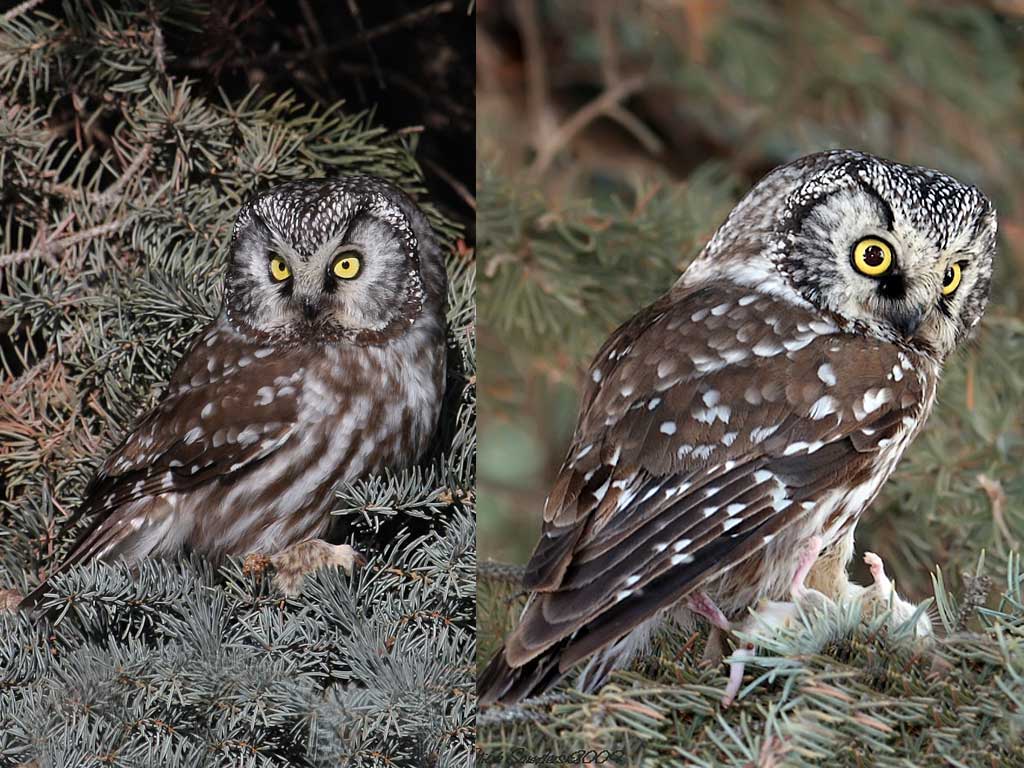
Boreal Owl
- Range: A permanent resident in a large part of Canada, Alaska, and parts of the Cascades and Rocky Mountains. Some migrate to southern Canada and the northern USA. Common in %STATE%.
- Length: 10 inches
- Wingspan: 21 inches
- Call: Makes a slightly rising, rapid serious of twelve brief hoot notes, “too, too, too, too, tu, tu, tu, tu, tu, tu, tu, tu”.
The Boreal Owl is a small owl species with a round or square-shaped head, and white face with a broken black border. It is dark brown with white spotting and has a black and white head.
Males and females look alike, although females are larger. This species also has yellow eyes, and a pale beak. Juvenile birds are mostly dark brown.
As the name hints, Boreal Owls like boreal forests. If you’re lucky, you might see one in northern areas.
Key Identifications:
- Small, dark brown and white owl with white spotting and a squared, black and white head.
- Lives in boreal and montane forest, some also winter at lower elevations and just south of its breeding range.
- Nests in old woodpecker holes and nest boxes.
- Watches from a perch before swooping down onto small animals at night.
Barn Owl – rare
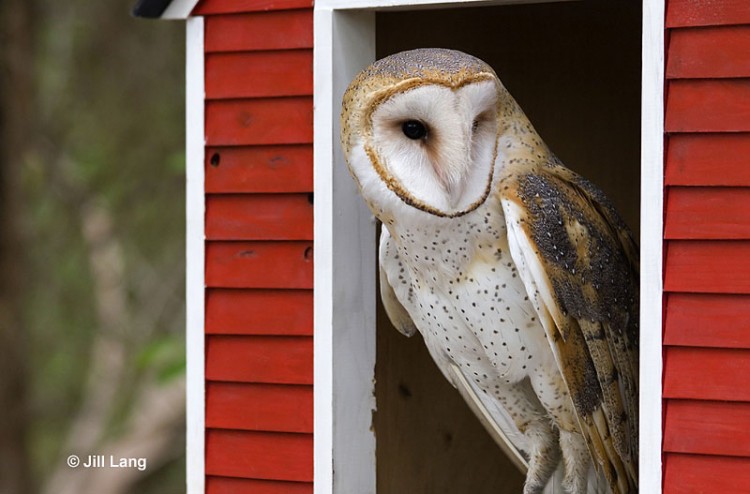
- Range: In Canada, occurs mostly in southwestern British Columbia. In the USA, they live in many areas but are absent from mountains and cold, northern regions. They range north to Washington, Nebraska, Iowa, and New York.
- Length: 16 inches
- Wingspan: 42 inches
- Call: A shrill, loud, hissing “shriiiiii!”
The Barn Owl is a medium to large, pale owl with golden tan and gray upperparts, and white underparts. It has a distinctive, white, heart-shaped face.
Both sexes are alike but females are a bit larger than males and have buff on their chest.
In flight, Barn Owls look like a large, pale, moth-like bird with a big, rounded head.
This owl hunts in grasslands, farms, and other open habitats. You might see one in southern parts of the state, but they are quite rare.
Key Identifications:
- Large pale owl with a heart-shaped face.
- Glides and flutters over fields and other open areas at night.
- Nests in tree cavities, crevices in church steeples and other structures, and next boxes.
- Preys on rats and other small animals.
Burrowing Owl – vagrant
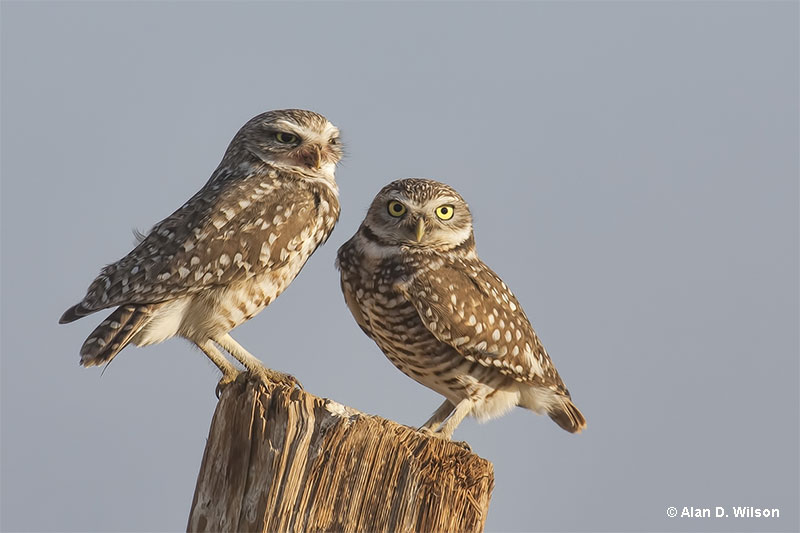
© Alan D. Wilson
- Range: Summer resident in central-southern Canada, the Great Plains, and much of the western USA. Permanent resident in California, Texas, and Florida.
- Length: 9.5 inches
- Wingspan: 21 inches
- Call: Makes a raspy, chattering call, “rap, rip,rip,rip,rip”, and a quail-like, “whup waaah!”.
The Burrowing Owl is a small, long-legged owl with a white throat and white eyebrows. It has a round head, is dark brown with white spots above, and has pale underparts with dark barring.
Males and females look alike although females are a bit larger. Young birds are uniform dark brown and buff.
If you happen to see one in Minnesota, it’s a rare vagrant, that lost its way.
Key Identifications:
- Small, long-legged owl with a round head, and some brown barring on pale underparts.
- Lives in grasslands and other wide-open habitats.
- Nests in burrows made by prairie dogs and other animals although birds in Florida make their own burrows.
- Catch small animals on the ground at any time of the day or night.
Frequently Asked Questions
What are the most common Minnesota owls?
The most common Minnesota owls are the Barred Owl, Great Horned Owl, and Eastern Screech-Owl.
Where can I see owls in Minnesota?
You can see owls in Minnesota in most wooded areas, and many open habitats too.
Are owls protected in Minnesota?
Yes, owls are protected in Minnesota under the Migratory Bird Treaty Act.
Do owls stay in MN in winter?
Yes, owls stay in MN in winter. This is actually the best time to see most owl species there including Snowy Owl, Great Gray Owl, and Northern Hawk Owl.
Read next: Birds in Minnesota | Hawks in Minnesota | Ducks in Minnesota

